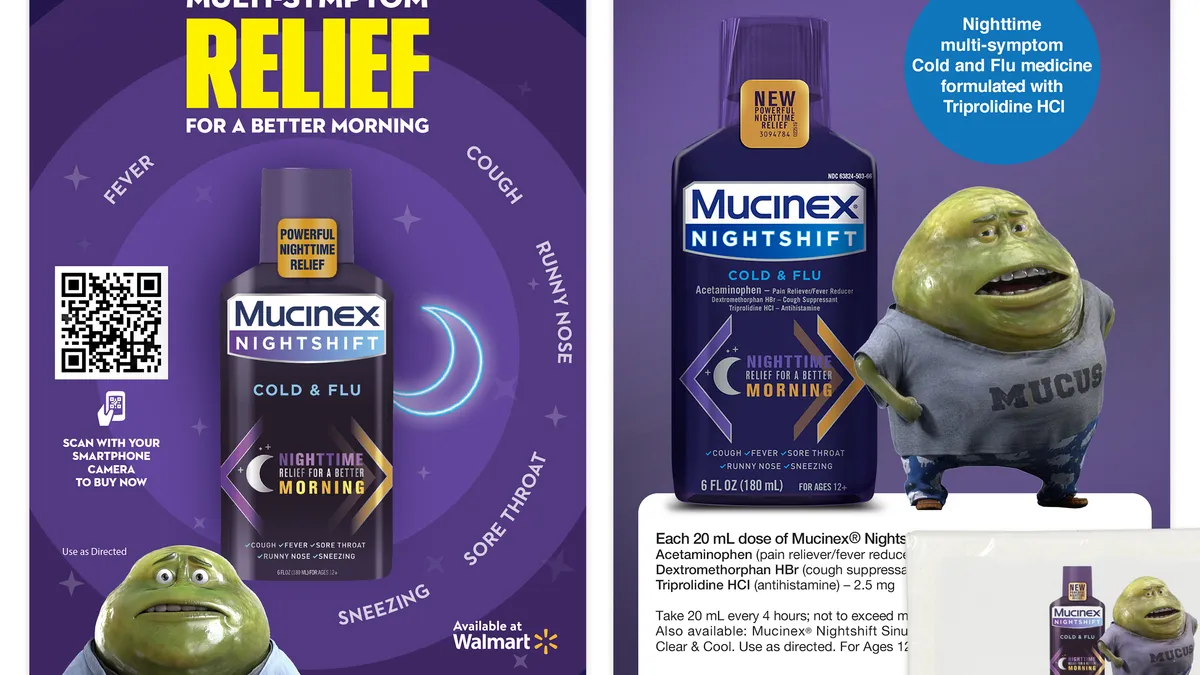Promoting a product that combats coughing and sneezing might not seem like the biggest marketing challenge during a pandemic, but when Mucinex first decided to try an experiment with at-home sampling, the world was a very different place.
In November of last year — long before the outbreak of COVID-19 upended traditional advertising strategies — Reckitt Benckiser Pharmaceuticals wanted to raise brand awareness for Mucinex Nightshift and drive more orders through e-commerce partners such as Walmart.
There was just one challenge: Walmart currently prohibits any item that contains dextromethorphan — an active ingredient in Mucinex Nightshift — to be sold on its site unless it is going to be picked up in store. In other words, it cannot be shipped.
So instead of sending samples of the actual product to consumers, Mucinex mailed out tissue packs, each of which featured information about Mucinex Nightshift as well as a QR code on the back. Those who scanned the code with their smartphone would be taken online, where they could watch the latest Mucinex TV spot as well as place orders that could be picked up in store.
"This regulation forced us to get a bit more creative with what was being mailed to the Walmart.com shopper as a 'sample' in this program," Ashley Keller, shopper marketing lead at Mucinex/Reckitt Benckiser, said. "This was about providing them something that would connect them back to the brand at a time period where they needed a cold product to remedy their symptoms, and where we could offer that surprise and delight."
The return of QR codes?
Mucinex sent the branded tissue packs to approximately 35,000 households and saw a 1.42% click-through rate. This translated into close to 15,000 products that wound up in online shopping carts, for a total product value of $241,257.
While QR codes have been available since the late 1990s, a pandemic-driven shift to online shopping by consumers and digital-first marketing strategies by brands could inspire other marketers to follow Mucinex’s lead.
New York-based Brandshare, which developed the campaign using technology from Atlanta-based SmartCommerce, has trademarked the term "Connected Sampling" to describe how this approach offers consumers a way to immediately take the next step and buy online.
"Years ago, you would buy a list, send your products and hope for the best," said Brandshare President Alan Verdun, referring to traditional in-home sampling programs.
"Then things evolved into doing a survey, and the survey engagement was probably less than one percent because you had to type in a URL and take the time to go to your computer."
While initial enthusiasm for QR codes faded, in part because the value in taking the time to engage with the codes wasn't apparent for some consumers, the technology may finally be ready for prime time, given that most smartphones now have built-in readers that makes it easier to scan them, Verdun added
There's also a potential opportunity to digitize sampling, with data collected in March by Brandshare and SmartCommerce showing the proportion of consumers buying groceries online has reached 60%, and 38% made their first such purchase around the time the study was conducted.
At the same time, marketers are questioning the feasibility of in-store sampling, once a mainstay of grocery stores, as many stores cease programs for safety reasons.
"If less people are travelling to brick-and-mortar stores, brands will be seeking to figure out how they can show their products. How are you going to get people to touch, to feel, to try new products?" Verdun said. "We believe that sampling has evolved in a big way to be able to interact with consumers, to follow up with them in one month, or several months later, to be able to share videos and maybe even turn some consumers into micro-influencers.”
From sampling to 'conversational commerce'
Keller, who works specifically on her brand's relationship with Walmart.com, said a campaign using QR codes was particularly helpful to ensure Mucinex would reach an audience that was based on the general population, but where its product would be in the spotlight.
"With this, the dollars are spent so much more wisely," she said. "We're reaching these shoppers in their homes, while they may already be ordering or getting ready to pick up their groceries. It's not a blanket kind of approach."
Verdun encouraged marketers to think of sampling with QR codes as a form of "conversational commerce," where consumers could not simply be directed to an e-commerce site but to online chat experiences or third-party platforms like Facebook Messenger. Doing so would not only be a way to prompt sales but to deepen customer relationships with personalized greetings and the ability to ask targeted questions.
"This could also be used on product displays that are done in-store," he added, where someone could scan a QR code while browsing physically. "This is not all about volume per se. It's all about looking to engage with quality, well-qualified consumers."
Keller said Mucinex is already exploring additional possibilities for the strategy, especially considering the fact this year’s flu season will likely be unlike any other in recent memory.
"For items that may have a blush factor in terms of purchasing in-store, I think this type of platform will help," she said. "It's definitely going to remain a key initiative for us."






















